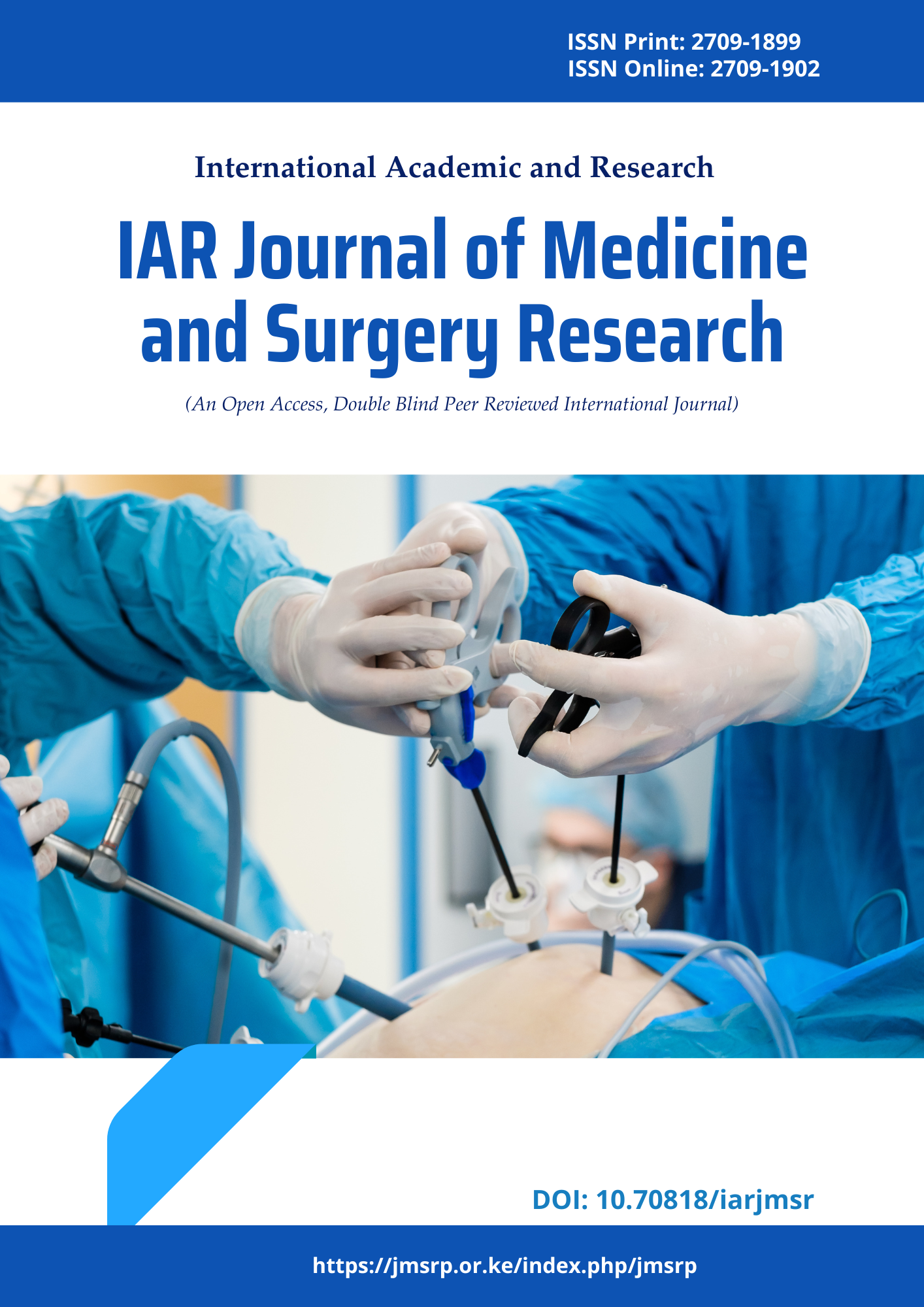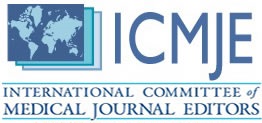Relationship Between Hypertension and Diabetes Understanding Their Co Morbidity and Clinical Management
DOI:
https://doi.org/10.70818/iarjmsr.2024.v05i06.0142Keywords:
Hypertension, Diabetes, Bangladesh, Clinical managementAbstract
Background: Hypertension and diabetes frequently co-exist, compounding morbidity and mortality, particularly in low-resource settings like Bangladesh. Objective: This study aims to assess the prevalence, risk factors, and clinical outcomes of hypertension-diabetes co-morbidity, evaluating management efficacy in a Bangladeshi tertiary hospital. Method: A cross-sectional study was conducted at a Department of Cardiology, Jamalpur Medical College, Jamalpur from January 2023 to June 2024, involving 114 patients diagnosed with both hypertension and diabetes. Patient data were obtained through medical records and structured interviews. Statistical analysis included chi-square tests to compare categorical variables, with significance set at p < 0.05. Results: Among 114 patients, 68.4% were male and 31.6% female, with an average age of 57.5 years. Patients over 60 years were significantly more likely to exhibit co-morbid complications (54%, p = 0.03). A high prevalence of obesity (47.3%) and sedentary lifestyle (64%) was noted. Poor glycemic and blood pressure control was prevalent, with only 28% achieving target blood pressure levels (p = 0.04) and 35% within target HbA1c ranges (p = 0.02). Cardiovascular complications were present in 42.1% of patients, while early-stage renal impairment was observed in 21% (p = 0.01). These findings underscore suboptimal co-morbidity management, highlighting limited implementation of lifestyle interventions. Conclusions: The study demonstrates a significant burden of hypertension-diabetes co-morbidity and supports the need for integrated management strategies to enhance patient outcomes in Bangladesh.
References
Gassner, L., Zechmeister-Koss, I., & Reinsperger, I. (2022). National strategies for preventing and managing non-communicable diseases in selected countries. Frontiers in Public Health, 10, 838051.
Peng, W., Zhang, L., Wen, F., Tang, X., Zeng, L., Chen, J., ... & Wang, Y. (2023). Trends and disparities in non-communicable diseases in the Western Pacific region. The Lancet Regional Health–Western Pacific.
Alicic, R. Z., Neumiller, J. J., & Tuttle, K. R. (2024). Diabetes Mellitus:: Management of Hypertension in Diabetes. In Hypertension (pp. 439-455). Elsevier.
wang, J., su, Y., Li, Y., su, T., & Li, Y. (2024). A Bibliometric Analysis of Research Hotspots and Frontiers in Diabetes and Cardiovascular Disease Comorbidity from 2005 to 2024. medRxiv, 2024-09.
Lee, J. K., McCutcheon, L. R., Fazel, M. T., Cooley, J. H., & Slack, M. K. (2021). Assessment of interprofessional collaborative practices and outcomes in adults with diabetes and hypertension in primary care: a systematic review and meta-analysis. JAMA network open, 4(2), e2036725-e2036725.
Phidza, M. (2020). Risk factors of non-communicable diseases, functional performance and physical fitness among female adults in a low-resourced community: B-Healthy study (Doctoral dissertation, North-West University (South Africa)).
Chowdhury, M. Z. I., Mubin, N., Mohib, T., Chowdhury, N., Chowdhury, T. F., Laskar, A. M. H., ... & Turin, T. C. (2024). Cancer screening research in Bangladesh: Insights from a scoping review. Global Public Health, 19(1), 2351186.
Ali, A., Manzoor, M. F., Ahmad, N., Aadil, R. M., Qin, H., Siddique, R., ... & Aizhong, L. (2022). The burden of cancer, government strategic policies, and challenges in Pakistan: A comprehensive review. Frontiers in nutrition, 9, 940514.
Arumugam, V. A., Thangavelu, S., Fathah, Z., Ravindran, P., Sanjeev, A. M. A., Babu, S., ... & Dhama, K. (2020). COVID-19 and the world with co-morbidities of heart disease, hypertension and diabetes. J Pure Appl Microbiol, 14(3), 1623-1638.
Wander, G. S., Panda, J. K., Pal, J., Mathur, G., Sahay, R., Tiwaskar, M., ... & Maheswari13, S. (2024). Management of Hypertension in Patients with Type 2 Diabetes Mellitus: Indian Guideline 2024 by Association of Physicians of India and Indian College of Physicians. hypertension, 35, 2.
Ghosh, S., Paul, M., Mondal, K. K., Bhattacharjee, S., & Bhattacharjee, P. (2023). Sedentary lifestyle with increased risk of obesity in urban adult academic professionals: an epidemiological study in West Bengal, India. Scientific reports, 13(1), 4895.
Rahman, M. A. (2022). Socioeconomic inequalities in the risk factors of noncommunicable diseases (hypertension and diabetes) among Bangladeshi population: Evidence based on population level data analysis. Plos one, 17(9), e0274978.
Groenewald, E. J. (2021). The effect of hypertension comorbidity in type 2 diabetes on inflammation, cardiovascular risk and hepatorenal function (Doctoral dissertation, Namibia University of Science and Technology).
Lu, Y., Wang, W., Liu, J., Xie, M., Liu, Q., & Li, S. (2023). Vascular complications of diabetes: A narrative review. Medicine, 102(40), e35285.
Mouton, A. J., Li, X., Hall, M. E., & Hall, J. E. (2020). Obesity, hypertension, and cardiac dysfunction: novel roles of immunometabolism in macrophage activation and inflammation. Circulation research, 126(6), 789-806.
Hossain, S., Chowdhury, P. B., Biswas, R. K., & Hossain, M. A. (2020). Malnutrition status of children under 5 years in Bangladesh: A sociodemographic assessment. Children and Youth Services Review, 117, 105291.
Rattu, V., & Hurst, D. (2022). Why don't general dental practitioners test for diabetes in periodontitis patients? How infrastructure, role identity and self-efficacy can prevent effective shared care. British Dental Journal, 232(11), 798-803.
Kabir, A., Karim, M. N., & Billah, B. (2022). Readiness of primary healthcare facilities for non-communicable diseases in Bangladesh.
Asif, M., Laghari, M., Mukwana, K. C., Hussain, S., Bashir, I., Siddiqque, M., ... & Abubakar, A. M. (2024). Groundwater Implications of Water Pollution in Pakistan: A Review on Sustainable Environmental Management of Solid Waste. Journal of Pollution Monitoring, Evaluation Studies and Control, 3(1), 47-58.
Cerimele, J. M., Fortney, J. C., Pyne, J. M., & Curran, G. M. (2019). Bipolar disorder in primary care: a qualitative study of clinician and patient experiences with diagnosis and treatment. Family practice, 36(1), 32-37.
Downloads
Published
Issue
Section
License
Copyright (c) 2024 Kantish Kumar Sarker, Md Rakibul Hasan Rashed, Abu Hena Mostafa Kamal, Md Abdul Baset, Fahad Bin Hafiz (Author)

This work is licensed under a Creative Commons Attribution 4.0 International License.















